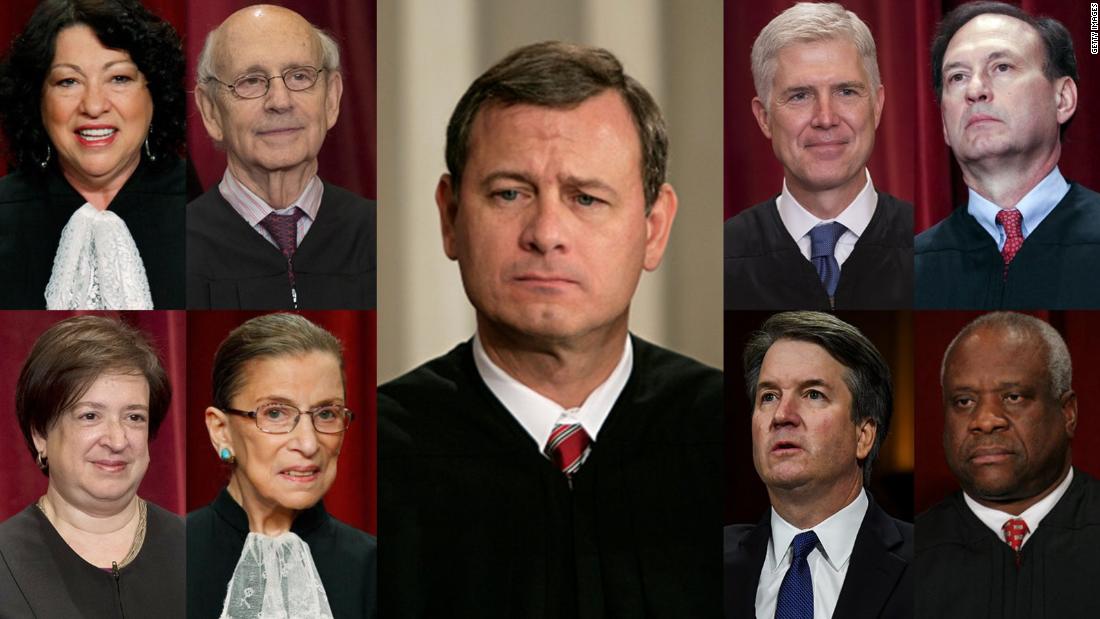[ad_1]
If this court is going to break out of its predictable political mold on major legal controversies in America, it will be up to the inscrutable 63-year-old chief justice, whose ideology now lands him at the center of the bench, between the four liberals and the four most dependable conservatives.
Yet unlike Anthony Kennedy, who Kavanaugh succeeded, Roberts is no centrist conservative with a record of joining the left on closely watched social policy disputes, such as to uphold abortion rights. The instincts of Roberts, who rose in Washington as he served Republican administrations, have always rested with the right wing.
Still, Roberts has demonstrated an investment in the reputation of the court, and of his own. The 2005 appointee of President George W. Bush loathes public criticism that casts the justices as politicians on the bench.
“We don’t work as Democrats or Republicans,” he has said.
How Roberts responds to the questions about the court’s legitimacy and partisan tendencies spurred by the Kavanaugh nomination could shape public perception of the court for the next generation. In his new pivotal position, Roberts’ moves in cases will also substantially influence the law throughout America.
On the near horizon are disputes over partisan gerrymandering and voting rights, environmental and other regulatory issues, and women’s reproductive rights and health care.
Roberts has already voted with fellow conservatives to lift campaign finance rules and to make it harder for civil rights groups to challenge state practices that encroach on voting rights. He authored the 2013 landmark ruling, Shelby County v. Holder, which lifted a long-standing requirement that certain states and cities with a history of discrimination at the polls obtain federal approval before instituting new electoral rules or districts.
As chief justice, Roberts already had considerable influence. He presides over oral arguments and the justices’ private sessions where they vote on cases. When he is in the majority — as is most often the situation — he decides who will write the opinion for the court. As such, the chief justice has been dubbed “the first among equals.”
Now, based on his past record, he would be situated at the middle, although not an ideological centrist. (Kavanaugh’s record on a Washington-based US appeals court would put him further to the right, aligned more Justices Samuel Alito or Neil Gorsuch.) Roberts would likely stick with his conservative brethren in most major cases but he would have new influence to shape a groundbreaking opinion or to determine which precedents were reversed.
Roberts’ statements and actions over the past 13 years suggest that he might inch to the left, to steady the court and soothe public reaction to the recent turmoil. He might take the lead to try to keep his fellow justices from being quick to hear incendiary cases. And he might try to find a middle ground, as he did with his 2012 vote to uphold the constitutionality of the Affordable Care Act, President Barack Obama’s signature domestic achievement that extended new insurance coverage to millions of Americans.
In the Obamacare fight, Roberts was not without his own doubts and tensions with colleagues as he navigated his way to the crucial vote, joining the court’s four liberals, to uphold the linchpin of the law — the individual insurance mandate — as a tax.
Perhaps his liberal colleague Kagan, who has reached across the divide to work with Roberts through the years, may have been thinking of him when she spoke on Friday about the need for a justice in the “middle” — and how Justices Kennedy and Sandra Day O’Connor (who served 1981-2006) had filled that role.
On Roberts’s right, with Kavanaugh, 53, Alito, 68, and Gorsuch, 51, is Justice Clarence Thomas, 70. On his left are Justices Ruth Bader Ginsburg, 85, Stephen Breyer, 80, Sonia Sotomayor, 64, and Elena Kagan, 58.
Kavanaugh’s partisan battle
Roberts has not spoken publicly about the Kavanaugh nomination. But he often criticizes the polarized confirmation process and rarely passes up the opportunity to assert that the court is not a political institution.
Trump’s first appointee, Neil Gorsuch, was confirmed in 2017, after Senate Republicans had refused to act on President Barack Obama’s choice of Judge Merrick Garland. During the turmoil, Roberts said the court at only eight justices simply kept doing its job.
“Throughout this whole process, the Supreme Court has been quietly going about its business of deciding the cases before it, according to the Constitution, in a completely nonpartisan way. … We in the judiciary do not do our business in a partisan, ideological manner,” Roberts said in April 2017.
Today those battles are eclipsed by this post-Kavanaugh moment. As Roberts read the Constitutional oath of office to Kavanaugh late Saturday, with their wives and other justices and guests gathered in the justices’ private conference room, protesters swarmed the exterior of the marble columned building. Many shouted, “Hey hey, ho ho, Kavanaugh has got to go.”
“I was very emotional last Thursday, more so than I have ever been. I might have been too emotional at times. I know that my tone was sharp, and I said a few things I should not have said,” he wrote.
Kavanaugh was confirmed 50-48 Saturday, with only one Democrat voting yes. Monday evening, Trump will host a ceremonial swearing-in for Kavanaugh at the White House.
Trump, it just so happens, was one of Roberts’ harshest critics when the chief justice joined the four liberals in the Obamacare case.
Years from his presidential bid and his current vow to appoint justices in his conservative image, Trump criticized Roberts in a series of tweets after the June 28, 2012 Obamacare decision.
[ad_2]
Source link





